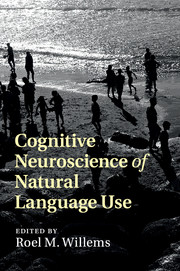Book contents
- Cognitive Neuroscience of Natural Language Use
- Cognitive Neuroscience of Natural Language Use
- Copyright page
- Contents
- Plates
- Figures
- Contributors
- Abbreviations
- 1 Cognitive neuroscience of natural language use: introduction
- 2 fMRI methods for studying the neurobiology of language under naturalistic conditions
- 3 Why study connected speech production?
- 4 Situation models in naturalistic comprehension
- 5 Language comprehension in rich non-linguistic contexts: combining eye-tracking and event-related brain potentials
- 6 The NOLB model: a model of the natural organization of language and the brain
- 7 Towards a neurocognitive poetics model of literary reading
- 8 Putting Broca’s region into context: fMRI evidence for a role in predictive language processing
- 9 Towards a multi-brain perspective on communication in dialogue
- 10 On the generation of shared symbols
- 11 What are naturalistic comprehension paradigms teaching us about language?
- Index
9 - Towards a multi-brain perspective on communication in dialogue
Published online by Cambridge University Press: 05 February 2015
- Cognitive Neuroscience of Natural Language Use
- Cognitive Neuroscience of Natural Language Use
- Copyright page
- Contents
- Plates
- Figures
- Contributors
- Abbreviations
- 1 Cognitive neuroscience of natural language use: introduction
- 2 fMRI methods for studying the neurobiology of language under naturalistic conditions
- 3 Why study connected speech production?
- 4 Situation models in naturalistic comprehension
- 5 Language comprehension in rich non-linguistic contexts: combining eye-tracking and event-related brain potentials
- 6 The NOLB model: a model of the natural organization of language and the brain
- 7 Towards a neurocognitive poetics model of literary reading
- 8 Putting Broca’s region into context: fMRI evidence for a role in predictive language processing
- 9 Towards a multi-brain perspective on communication in dialogue
- 10 On the generation of shared symbols
- 11 What are naturalistic comprehension paradigms teaching us about language?
- Index
Summary
In conversation, speakers and listeners coordinate both their behavior and their mental states. Multi-brain studies, which record and relate to each other the neural activity of two or more brains, can provide insights into a coordination of neural states between communicating individuals. In this chapter we review recent multi-brain studies using functional magnetic resonance imaging (fMRI) or electroencephalography (EEG) to investigate verbal and non-verbal communication. We summarize common findings with respect to spatial and temporal aspects of inter-brain coordination. We then critically discuss challenges arising from studying dialogue in ecologically valid, yet experimentally controlled neuroscientific settings. We conclude by providing an outlook of how technical and methodological advances may enable future multi-brain studies to better address these challenges.
- Type
- Chapter
- Information
- Cognitive Neuroscience of Natural Language Use , pp. 182 - 200Publisher: Cambridge University PressPrint publication year: 2015
- 8
- Cited by

